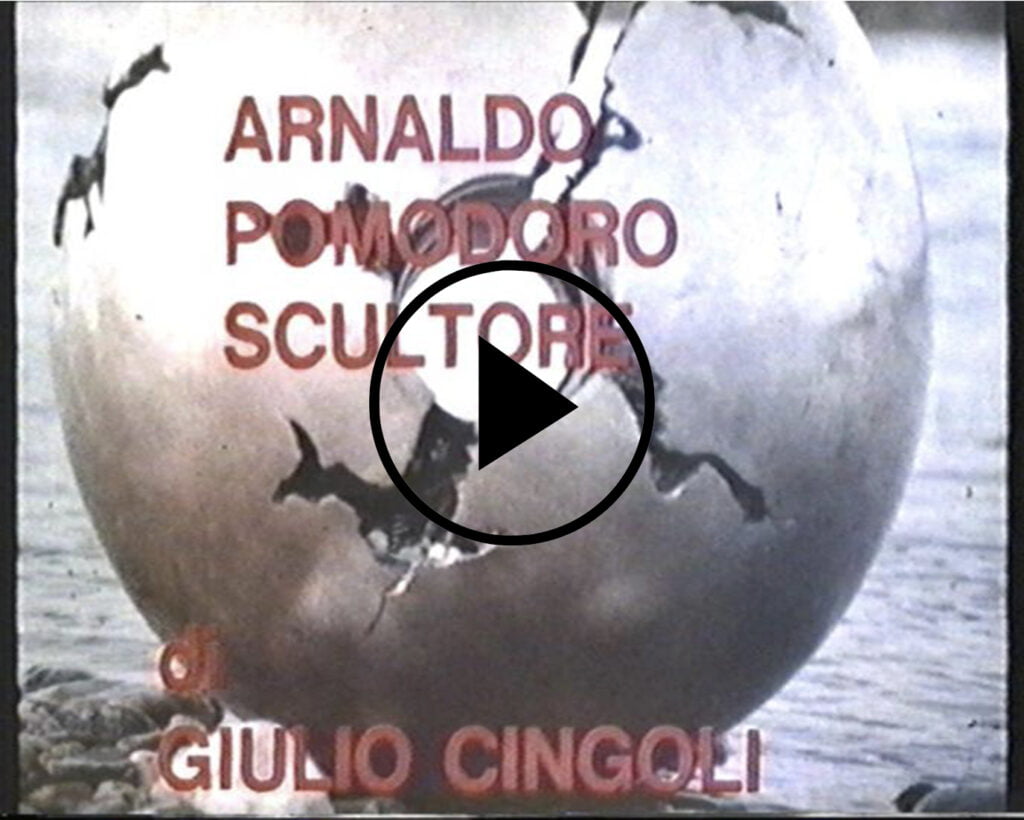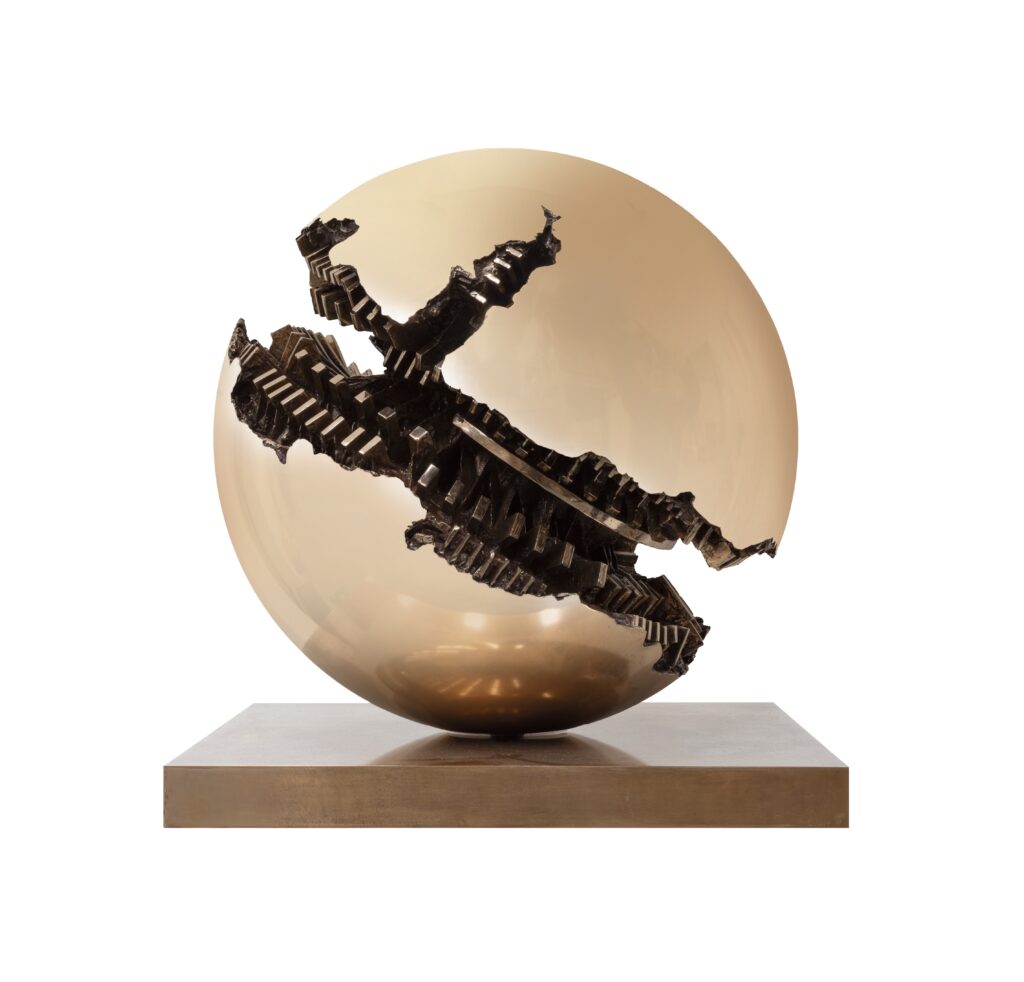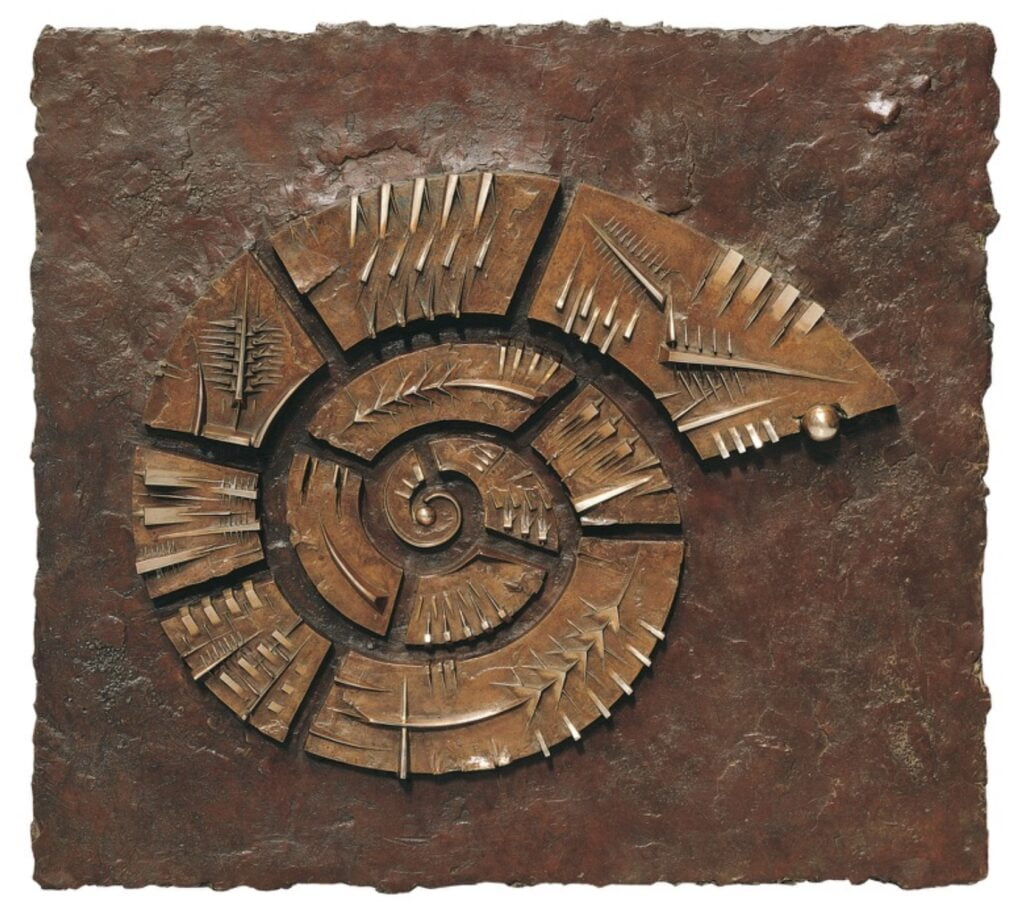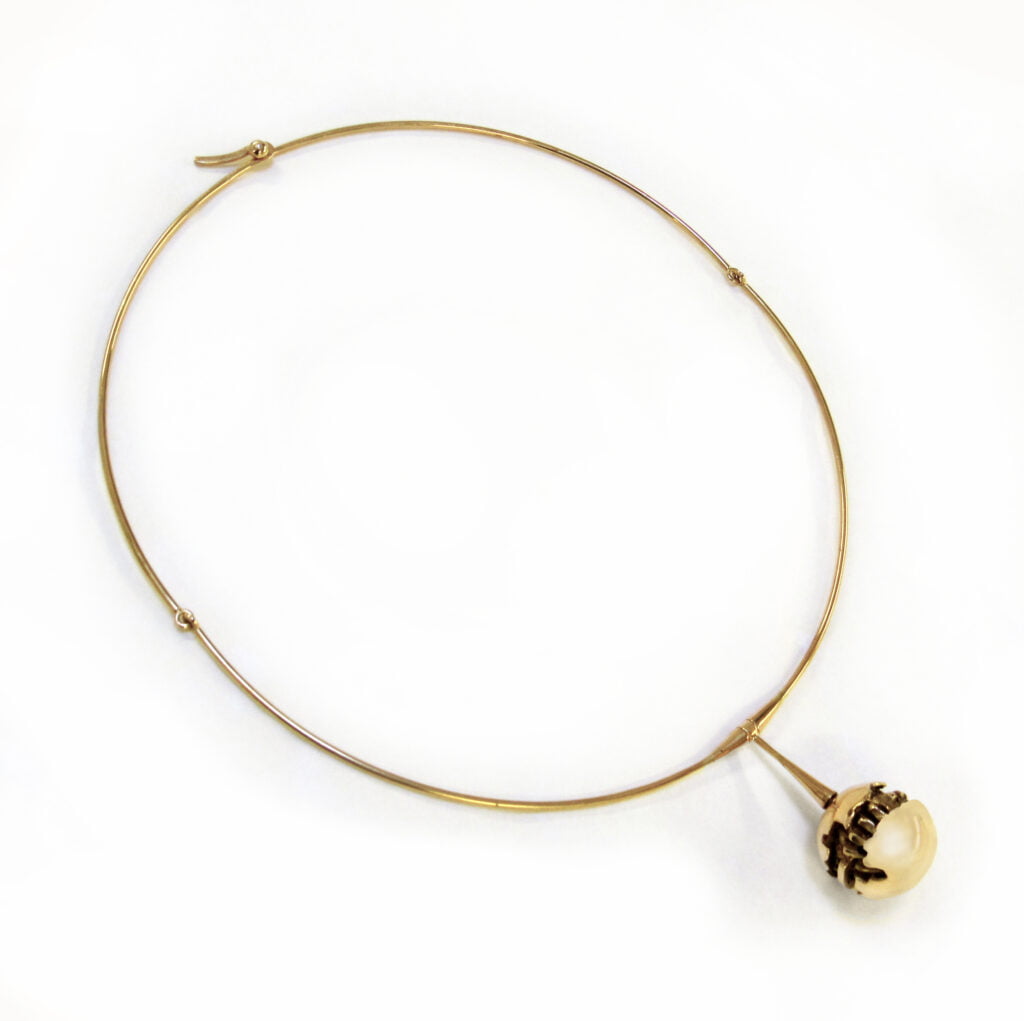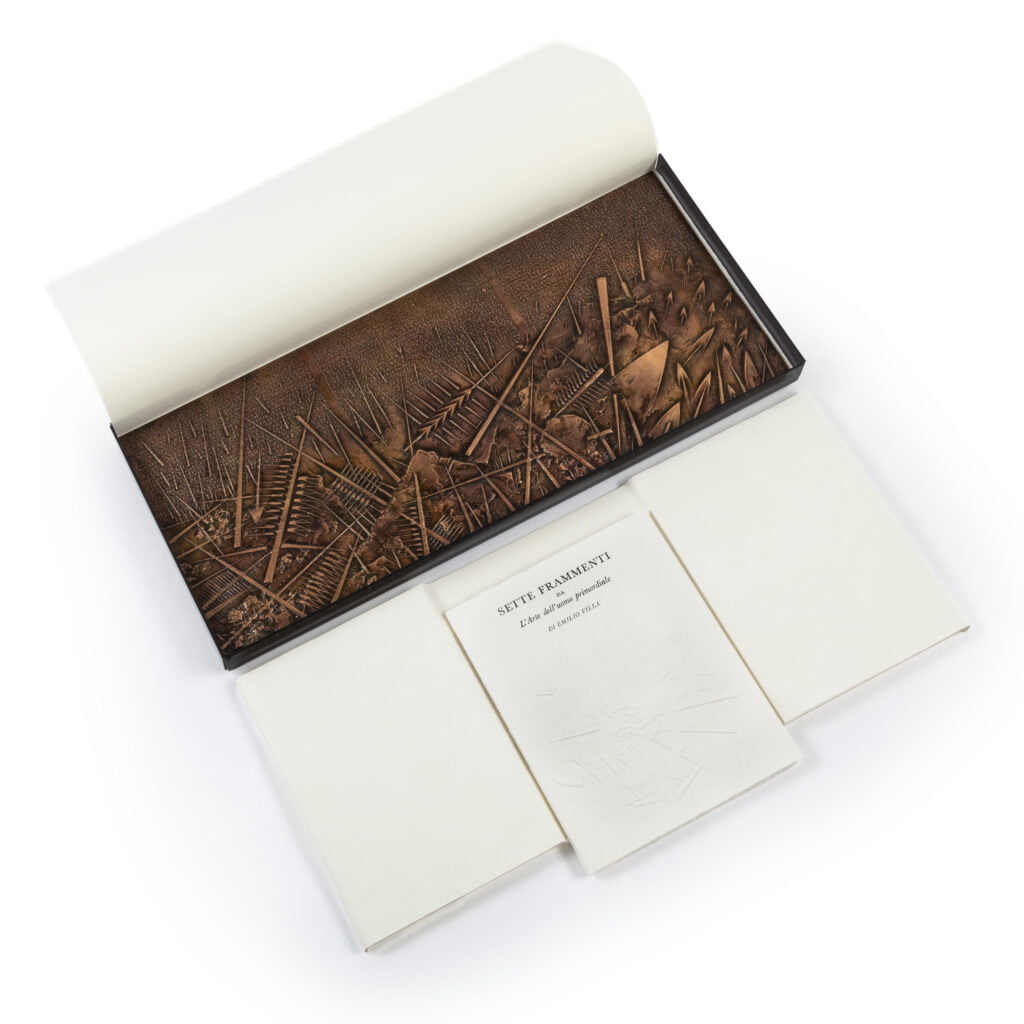Speaking of...
ARNALDO POMODORO
“An artist is first and foremost a man, and his work is related to his entire experience as a human being.“
– Arnaldo Pomodoro
Arnaldo Pomodoro was born in Morciano di Romagna in 1926 and spent his childhood in Pesaro. In 1954, he moved to Milano, where he has lived and worked since then.
Sculptural Writing. In the 1950s, Pomodoro’s production was known for creating high reliefs with unique and recognisable sculptural “writing.”
This phase marks a significant moment for the artist and contemporary sculpture as Pomodoro moves away from traditional conventions to explore new forms of expression. He thus ventures into unknown territory, experimenting with a wide range of materials and techniques. Bronze, steel, and other metals become the mediums through which he expresses his artistic vision. Through casting, modelling, chiselling, and other methods, Pomodoro creates works that convey vitality and a unique expressive force.
Three-dimensionality and Geometry: In the early 1960s, Pomodoro began his research on three-dimensionality and geometric forms: spheres, disks, pyramids, cones, columns, and cubes – all in bronze – were dug into their depths to explore the mystery hidden within formal perfection. The contrast between the shiny exterior and the chaotic complexity of their inner core becomes consistent in Master’s work.
Arnaldo Pomodoro established in 1995 the Fondazione that bears his name (www.fondazionearnaldopomodoro.it) and that promotes his pioneering and innovating spirit: because, far from the being a static and conservative structure, the Fondazione can fulfil the function of a genuinely inventive, almost experimental laboratory, aiming in this way to build up a profound and global involvement with artists, critics and the public.
Monumental and Public Works
In 1966, the artist was commissioned to create a sphere that was three and a half meters in diameter for the Montreal Expo. This sculpture was later placed in front of the Farnesina in Rome and marked the beginning of his production of monumental sculptures. Several of the artist’s works are now placed in symbolically important public spaces, such as squares in Milan, Copenhagen, Brisbane, Los Angeles and Darmstadt, in front of Trinity College in Dublin, at Mills College in California, in the Cortile della Pigna in the Vatican, in front of the United Nations in New York and at the Paris headquarters of UNESCO.
A distinctive feature of Pomodoro’s monumental works is their dynamic interaction with the surrounding space. Rather than merely occupying space, the sculptures interact with it dynamically, creating a distinctive and memorable relationship.
- Sfera con sfera – One of Pomodoro’s most famous works; in fact, the spherical shape represents his artistic production’s archetype. This sculpture can be found in many cities worldwide, for instance, in Città del Vaticano (in the Cortile della Pigna of the Vatican Museums), Dublin (at Trinity College) and New York (at the United Nations Headquarters). These impressive bronze sculptures are made up of a large hollow sphere, inside which another smaller sphere is positioned, thus creating a unique visual and perceptual effect.
- Grande Disco – Located in Milano, in Piazza Meda stands the imposing Disk sculpture, made of bronze and characterised by grooves and engravings that cross its surface, symbolising innovation and creativity in the city’s heart.
Novecento – This bronze spiral located in Rome, Piazzale Pier Luigi Nervi, stands over 21 meters tall. The spiral’s surface is marked by a series of grooves and incisions that create an effect of dynamism and movement. These grooves and incisions represent the journey as a metaphor for the inner quest.
- Colpo d’ala: omaggio a Boccioni – This sculpture, exhibited at the Department of Water and Power in Los Angeles, conveys a strong sense of movement and dynamism, evoking the dynamic energy of Umberto Boccioni’s Futurism.
Environmental Works
Arnaldo Pomodoro has created many environmental works, ranging from the Project for the New Urbino Cemetery in 1973, which was designed to be dug into a hillside in Urbino but was never built. He also created the Moto Terreno Solare, a long concrete wall for Il Simposio di Minoa in Marsala, and La Battaglia in the Sala d’Armi’s vault for the Museo Poldi Pezzoli in Milan. Other notable works by Pomodoro are il Labirinto, dedicated to the epic of Gilgamesh and completed in 2011, and Carapace, a winery in Bevagna built for the Lunelli family.
Theatrical Set Designs
Pomodoro’s theatrical sets have been used in a wide range of productions, from classical tragedies to contemporary theatre, ballet, and opera. Through the skilful use of materials, colours, and shapes, the artist has created sets that become an integral part of the narrative and enhance the viewer’s aesthetic experience. The artist’s fascination with storytelling and writing is evident in his collaborations with poets and literati to create extraordinary artists’ books.
The Fusion of Sculptural Art and Jewellery
Arnaldo Pomodoro considers jewellery not simply ornamental accessories but actual works of art intended to be worn. Each piece is conceived with meticulous care and attention to detail, reflecting the same passion and dedication the artist employs in his monumental sculptures. Pomodoro jewels are the result of a harmonious fusion of sculptural art and artisanal tradition of Italian jewellery craftsmanship, combining bold shapes and exquisite materials to create works that stand out for their beauty and originality.
Recognitions and Awards
Memorable retrospectives have consolidated his reputation as one of our time’s most significant contemporary artists. His works have been exhibited on different continents, such as Europe, America, Australia and Japan.
Arnaldo Pomodoro has taught in the art departments of various American universities: Stanford University, University of California at Berkeley, and Mills College.
He has received numerous honours and awards throughout his career, including the Sculpture Awards at the São Paulo and Venice Biennales, the Praemium Imperiale for Sculpture from the Japan Art Association, and the Lifetime Achievement in Contemporary Sculpture Award from the International Sculpture Center in San Francisco.
Arnaldo pomodoro: IL MOVIMENTO POSSIBILE
Installation view, Arnaldo Pomodoro: il movimento possibile, curated by Alberto Salvadori, in collaboration with Fondazione Arnaldo Pomodoro, Cortesi Gallery Milan, 2024. Ph. Fabio Mantegna
Cortesi Gallery Milano is delighted to present the exhibition Arnaldo Pomodoro: il movimento possibile, curated by Alberto Salvadori, realized in collaboration with the Fondazione Arnaldo Pomodoro and supported by It’s Art. The exhibition is a fascinating incursion into the extraordinary career of one of the most significant artists of our time, through an itinerary exploring less well-known aspects of the sculptor’s work. Both the bronze sculptures representing the elementary forms of geometric solids and works with various formats and materials are present in the exhibition, the latter enabling Pomodoro’s research to be examined in constant relations starting from the micro-dimension, from the planning and realization of the first jewellery items, to interventions of an architectural and landscaping nature.

SELECTED WORKS
Sfera
“A sphere is a marvelous object, from the world of magic, wizards, whether it is of crystal or bronze, or full of water… It reflects everything around it, creating such contrast that it sometimes is transformed, becoming invisible, leaving only its interior, tormented and eroded, full of teeth […] That’s what drives me to make the spheres: breaking these perfect, magic forms in order to reveal its internal ferment, mysterious and alive, monstuos and yet pure; so I create a discordant tension, a conflict, with the polished shine: a unity composed of incompleteness.”
– Arnaldo Pomodoro
La Colonna del Viaggiatore
“The column not only corresponds to an elementary geometric form, the cylinder, but also constitutes a strong motif in memories. A relationship is established between the outer surface, on which I have made longitudinal and transverse splits, and the signs, intended as the writing interventions, which emerge from its interior. The Traveller’s Column, in particular, indicates the desire to discover space (after Gagarin’s flight, for me, the traveller was the new conqueror of the cosmos) and refers to the varied theme of travel, which is also conversation; it is present, past, memory and fantasy, it is movement.”
– Arnaldo Pomodoro
200 × 27 × 30 cm (with artist’s plint)
Lunghe tracce concentriche
“The spiral shape (of Tracce) is a reminiscence of the ancient Aztec culture and rises from the ground to be seen from above. It is also a settlement and a rose in the desert.”
– Arnaldo Pomodoro
Collana con Sfera
“By using this ancient craft method, I achieved an incredible mental jump-start, and it has become crucial to all my work. Even today, I make my sculptures, working in the negative for a positive outcome.”
– Arnaldo Pomodoro
Libro d'Artista
The book, which was published on the occasion of the 65th anniversary of the “Cento Amici del Libro” Association, contains seven unpublished texts by Emilio Villa and seven graphic works by Arnaldo Pomodoro, with a preface by Aldo Tagliaferri. The eight bronze reliefs Frammento I-VIII and Impronta have been taken from this edition.

